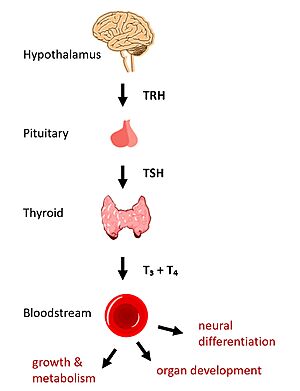Sandbox Reserved 1774
From Proteopedia
(Difference between revisions)
| Line 25: | Line 25: | ||
=== Stabilizing Interactions in the Hinge === | === Stabilizing Interactions in the Hinge === | ||
| - | To understand stabilizing interactions which accommodate the hinge motion, the hinge region can be subdivided into the <scene name='95/952702/Hinge_helix_intro/ | + | To understand stabilizing interactions which accommodate the hinge motion, the hinge region can be subdivided into the <scene name='95/952702/Hinge_helix_intro/3'>hinge helix</scene>, which lies at the intersection of the extracellular and transmembrane domains; <scene name='95/952702/Helix_1_intro/5'>helix 1</scene>, which sticks up and serves as a binding platform for the TSH ligand; the <scene name='95/952702/Linker_intro/4'>linker</scene> region, which connects helix 1 with the p10 region; and the <scene name='95/952702/P10_intro/2'>p10</scene> region, a conserved 10-amino acid sequence which connects to transmembrane helix 7 and undergoes most of the deformation <ref name="Faust" /> <ref name="Duan">PMID:35940204</ref>. |
Two key disulfide bridges within the hinge region help to maintain its structure and orientation <ref name="Duan" />. | Two key disulfide bridges within the hinge region help to maintain its structure and orientation <ref name="Duan" />. | ||
| - | #The <scene name='95/952702/P10_hinge_disulfide/ | + | #The <scene name='95/952702/P10_hinge_disulfide/2'>first disulfide bridge</scene> connects the hinge helix with the linker region |
#The <scene name='95/952702/Linker_hinge_disulfide/1'>second disulfide bridge</scene> connects the hinge helix with the p10 region. | #The <scene name='95/952702/Linker_hinge_disulfide/1'>second disulfide bridge</scene> connects the hinge helix with the p10 region. | ||
The upright, active conformation of the hinge is stabilized by its respective interactions wit the EC and TM domains <ref name="Faust" />. | The upright, active conformation of the hinge is stabilized by its respective interactions wit the EC and TM domains <ref name="Faust" />. | ||
| - | #A <scene name='95/952702/Hydrophobic_interaction/ | + | #A <scene name='95/952702/Hydrophobic_interaction/2'>hydrophobic interaction</scene> occurs between Y279 in the hinge helix and I486 in EC loop region 1, which protrudes from the TM helices. |
| - | #An <scene name='95/952702/Ionic_interaction/ | + | #An <scene name='95/952702/Ionic_interaction/3'>ionic interaction</scene> occurs between K660 in TM helix 7 and E409 in the p10 region. |
If the stabilizing interactions are disrupted, TSHR function is affected. For instance, the mutation I496F has been observed to cause constitutive receptor activation and decreased sensitivity to the TSH ligand, suggesting that the bulkier phenylalanine strengthens the hydrophobic interaction too much leading to overactivation. Contrastingly, TSHR underactivation results from disrupting the ionic interaction with an E409A mutation, which is associated with diminished receptor activation and TSH potency <ref name="Faust" />. | If the stabilizing interactions are disrupted, TSHR function is affected. For instance, the mutation I496F has been observed to cause constitutive receptor activation and decreased sensitivity to the TSH ligand, suggesting that the bulkier phenylalanine strengthens the hydrophobic interaction too much leading to overactivation. Contrastingly, TSHR underactivation results from disrupting the ionic interaction with an E409A mutation, which is associated with diminished receptor activation and TSH potency <ref name="Faust" />. | ||
Revision as of 23:05, 2 April 2023
| This Sandbox is Reserved from February 27 through August 31, 2023 for use in the course CH462 Biochemistry II taught by R. Jeremy Johnson at the Butler University, Indianapolis, USA. This reservation includes Sandbox Reserved 1765 through Sandbox Reserved 1795. |
To get started:
More help: Help:Editing |
| |||||||||||

